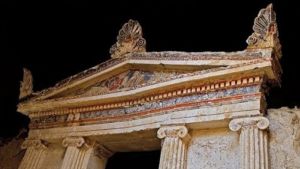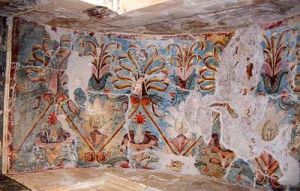Difference between revisions of "Language/Modern-greek-1453/Culture/Tomb-of-the-Palmettes-Mieza-Grèce"
(Nouvelle leçon) |
|||
| Line 1: | Line 1: | ||
[[File:ΤΑΦΟΣ-ΑΝΘΕΜΙΩΝ-1-678x381.jpg|thumb|none]] | |||
== '''Tomb of the Palmettes / Flowers, Mieza-Grèce''' == | == '''Tomb of the Palmettes / Flowers, Mieza-Grèce''' == | ||
The Tomb of the Flowers, one of the most magnificent and best preserved monuments of ancient Mieza, lies together with other similar tombs, like the Tomb of Judgement only a hundred and fifty metres to the east, along the ancient road connecting Mieza with Pella, the capital of the kingdom of Macedon. The Tomb of the Flowers dates to the first half of the third century BC, and so is contemporary with the 'Kinch' Tomb in the same area. | The Tomb of the Flowers, one of the most magnificent and best preserved monuments of ancient Mieza, lies together with other similar tombs, like the Tomb of Judgement only a hundred and fifty metres to the east, along the ancient road connecting Mieza with Pella, the capital of the kingdom of Macedon. The Tomb of the Flowers dates to the first half of the third century BC, and so is contemporary with the 'Kinch' Tomb in the same area. | ||
The Tomb of the Palmettes, sometimes known as the Rhomiopoulou Tomb, is an ancient Macedonian tomb of the Hellenistic period in Mieza, Macedonia, Greece, noted for the quality of its painted decoration. It was built in the first half of the third century BC. The tomb was discovered in 1971 after illegal excavations. A metal structure was built over the tomb in 1988 to protect it from the elements, but restoration work is still ongoing. | The Tomb of the Palmettes, sometimes known as the Rhomiopoulou Tomb, is an ancient Macedonian tomb of the Hellenistic period in Mieza, Macedonia, Greece, noted for the quality of its painted decoration. It was built in the first half of the third century BC. The tomb was discovered in 1971 after illegal excavations. A metal structure was built over the tomb in 1988 to protect it from the elements, but restoration work is still ongoing. | ||
[[File:tombAnthemion_mainpage (1).jpg|thumb|none]] | |||
After the burial of the deceased and the completion of the customary funerary rites this subterranean funerary monument was covered by a tumulus over 2.50 metres high and 15-17 metres in diameter. The tomb consists of two barrel-vaulted chambers and a temple-shaped fa?ade with four engaged Ionic columns and polychrome Ionic and Doric kymatia. The entrance to the tomb was sealed with six poros blocks. The one metre high tympanon of the pediment was decorated with a beautiful painted scene depicting an elderly couple reclining on a symposium couch. Both figures wear a chiton and himation with opulent folds. The pediment is crowned by three palmettes painted in chiaroscuro. The walls in the narrow ante-chamber were painted black in the lower part and white in the upper part, the two colours being divided by bands of black and white. A beautiful painting of six flowers alternating with water-lilies on a blue-green background, as if floating on the surface of a pond, adorns the ceiling. A double door of marble, 3.50 metres high and 0.90 metres wide, with relief motifs separates the ante-chamber from the burial chamber. The latter preserves a rectangular stone base, upon which stood the box or larnax containing the bones of the deceased. The vaulted ceiling is covered with pale yellow plaster, and the walls were painted in imitation of marble revetment, black in their lower part and red in their upper part, the two colours being divided by a white band. The monument's characteric Ionic decoration, with its detailed design and polychromy, provides useful information for both its dating and for large-scale painting in Greece. Although the tomb was looted several times in antiquity enough furnishings remain to offer a glimpse of the opulent grave gifts it once contained. Especially important are the ivory plaques from the revetment of a bed. | After the burial of the deceased and the completion of the customary funerary rites this subterranean funerary monument was covered by a tumulus over 2.50 metres high and 15-17 metres in diameter. The tomb consists of two barrel-vaulted chambers and a temple-shaped fa?ade with four engaged Ionic columns and polychrome Ionic and Doric kymatia. The entrance to the tomb was sealed with six poros blocks. The one metre high tympanon of the pediment was decorated with a beautiful painted scene depicting an elderly couple reclining on a symposium couch. Both figures wear a chiton and himation with opulent folds. The pediment is crowned by three palmettes painted in chiaroscuro. The walls in the narrow ante-chamber were painted black in the lower part and white in the upper part, the two colours being divided by bands of black and white. A beautiful painting of six flowers alternating with water-lilies on a blue-green background, as if floating on the surface of a pond, adorns the ceiling. A double door of marble, 3.50 metres high and 0.90 metres wide, with relief motifs separates the ante-chamber from the burial chamber. The latter preserves a rectangular stone base, upon which stood the box or larnax containing the bones of the deceased. The vaulted ceiling is covered with pale yellow plaster, and the walls were painted in imitation of marble revetment, black in their lower part and red in their upper part, the two colours being divided by a white band. The monument's characteric Ionic decoration, with its detailed design and polychromy, provides useful information for both its dating and for large-scale painting in Greece. Although the tomb was looted several times in antiquity enough furnishings remain to offer a glimpse of the opulent grave gifts it once contained. Especially important are the ivory plaques from the revetment of a bed. | ||
| Line 12: | Line 14: | ||
I. Psarra, archaeologist | I. Psarra, archaeologist | ||
{{Marianthi-Signature}} | |||
Revision as of 11:19, 23 March 2024
Tomb of the Palmettes / Flowers, Mieza-Grèce
The Tomb of the Flowers, one of the most magnificent and best preserved monuments of ancient Mieza, lies together with other similar tombs, like the Tomb of Judgement only a hundred and fifty metres to the east, along the ancient road connecting Mieza with Pella, the capital of the kingdom of Macedon. The Tomb of the Flowers dates to the first half of the third century BC, and so is contemporary with the 'Kinch' Tomb in the same area.
The Tomb of the Palmettes, sometimes known as the Rhomiopoulou Tomb, is an ancient Macedonian tomb of the Hellenistic period in Mieza, Macedonia, Greece, noted for the quality of its painted decoration. It was built in the first half of the third century BC. The tomb was discovered in 1971 after illegal excavations. A metal structure was built over the tomb in 1988 to protect it from the elements, but restoration work is still ongoing.
After the burial of the deceased and the completion of the customary funerary rites this subterranean funerary monument was covered by a tumulus over 2.50 metres high and 15-17 metres in diameter. The tomb consists of two barrel-vaulted chambers and a temple-shaped fa?ade with four engaged Ionic columns and polychrome Ionic and Doric kymatia. The entrance to the tomb was sealed with six poros blocks. The one metre high tympanon of the pediment was decorated with a beautiful painted scene depicting an elderly couple reclining on a symposium couch. Both figures wear a chiton and himation with opulent folds. The pediment is crowned by three palmettes painted in chiaroscuro. The walls in the narrow ante-chamber were painted black in the lower part and white in the upper part, the two colours being divided by bands of black and white. A beautiful painting of six flowers alternating with water-lilies on a blue-green background, as if floating on the surface of a pond, adorns the ceiling. A double door of marble, 3.50 metres high and 0.90 metres wide, with relief motifs separates the ante-chamber from the burial chamber. The latter preserves a rectangular stone base, upon which stood the box or larnax containing the bones of the deceased. The vaulted ceiling is covered with pale yellow plaster, and the walls were painted in imitation of marble revetment, black in their lower part and red in their upper part, the two colours being divided by a white band. The monument's characteric Ionic decoration, with its detailed design and polychromy, provides useful information for both its dating and for large-scale painting in Greece. Although the tomb was looted several times in antiquity enough furnishings remain to offer a glimpse of the opulent grave gifts it once contained. Especially important are the ivory plaques from the revetment of a bed.
The tomb is accessible to visitors. Soon, the shelter will be extended and the earthen tumulus, which once covered the monument, will be restored.
Author
I. Psarra, archaeologist
Author
- Ευγενική χορηγία που στοχεύει να βοηθήσει μαθητές ή μη, απανταχού της Γης, που επιδίδονται στην εκμάθηση της ελληνικής γλώσσας!
- Contribution bénévole visant à aider les personnes, partout dans le monde, qui sont engagées dans l'apprentissage de la langue grecque !
- Voluntary contribution aimed at helping people, all over the world, who are committed to learning the Greek language!

